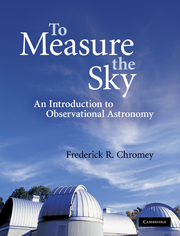1 - Light
Published online by Cambridge University Press: 05 June 2012
Summary
Always the laws of light are the same, but the modes and degrees of seeing vary.
– Henry David Thoreau, A Week on the Concord and Merrimack Rivers, 1849Astronomy is not for the faint of heart. Almost everything it cares for is indescribably remote, tantalizingly untouchable, and invisible in the daytime, when most sensible people do their work. Nevertheless, many – including you, brave reader – have enough curiosity and courage to go about collecting the flimsy evidence that reaches us from the universe outside our atmosphere, and to hope it may hold a message.
This chapter introduces you to astronomical evidence. Some evidence is in the form of material (like meteorites), but most is in the form of light from faraway objects. Accordingly, after a brief consideration of the material evidence, we will examine three theories for describing the behavior of light: light as a wave, light as a quantum entity called a photon, and light as a geometrical ray. The ray picture is simplest, and we use it to introduce some basic ideas like the apparent brightness of a source and how that varies with distance. Most information in astronomy, however, comes from the analysis of how brightness changes with wavelength, so we will next introduce the important idea of spectroscopy. We end with a discussion of the astronomical magnitude system. We begin, however, with a few thoughts on the nature of astronomy as an intellectual enterprise.
- Type
- Chapter
- Information
- To Measure the SkyAn Introduction to Observational Astronomy, pp. 1 - 34Publisher: Cambridge University PressPrint publication year: 2010

